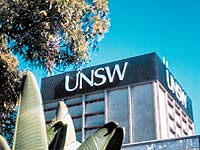Design - 5306
Program Summary
Faculty: Faculty of Art & Design
Contact: www.artdesign.unsw.edu.au
Campus: Paddington
Career: Postgraduate
Typical UOC Per Semester: 24
Min UOC Per Semester: 6
Max UOC Per Semester: 24
Min UOC For Award: 48
View program information for previous years
Program Description
The Graduate Diploma in Design has two main components: a core of design courses and practice-based classes from a number of design studios.
In the design core you will learn to integrate of technology, design thinking, experimentation, strategy and communication.
The studio-based courses enable you to either focus on a specific area of design and digital practice, or to put together your own suite of courses from across design, craft, digital media and creative leadership.
Studio-based design courses can be taken in the following areas:
- Experience Design engages with the design of products, processes, services, events and environments, with a focus on the quality of the user experience.
- Interaction Design addresses visual communication and user-experience across graphics, media and emergent inter-actives.
- Visualisation and Video Effects focuses on the practices of designing for animation, 3D, sound, film, video, illustration and computing
- Graphic Communication which addresses graphic design for paper and print, the screen and broadcast, encompassing contemporary typography, graphic design and cross-cultural communication strategies in designing for different audiences.
- Future Making focuses on the making of objects, with new materials and digital technologies and craftsmanship. It addresses the integration of technical knowledge and skills with material and contextual understanding. Future Making works with ceramics, jewellery, metal, textiles, furniture and lighting.
- Planar Practices which engages with creative practice using colour, line, and surface. It works across the disciplines of painting, drawing, printmaking and the screen.
- Temporal and Spatial Practices addresses creative practice using lens, time, space and objects. It works arcoss the disciplines of photography, video, animation, sculpture, installation and performance.
Program Objectives and Graduate Attributes
Program Structure
- Four courses (24 UOC) from those approved in the following Design Studios: Experience Design, Interaction Design, Visualisation and Video Effects, Graphic Communication or Future Making.
9313 Master of Design.
Academic Rules
- 24 UOC in Core courses
- 24 UOC in approved studio courses
Fees
Entry Requirements
Applicants who apply with a bachelors degree completed more than 10 years ago can be admitted to the Graduate Certificate in Design where they have 5 or more years professional experience in a design or media-related field since graduation. They can articulate up to the Graduate Diploma if they hold a credit average in their courses taken under the Graduate Certificate.
Applicants without a Bachelors degree may be admitted to the Graduate Certificate on a case-by-case basis by the Program Director, on the basis of a Portfolio of work and professional experience. The student may articulate up to the Graduate Diploma if they hold a credit average in their courses taken under the Graduate Certificate.
Recognition of Prior Learning (RPL)
Consideration of RPL, including industry experience, will be relevant for:
a) entry into the program without a Bachelors degree; and
b) entry with a Bachelors degree awarded more than 10 years prior to proposed year of commencement.
Verified industry experience will include a written statement of service from an employer, client or commissioning agent verifying the position, role, responsibilities, duration and/or project outcomes of employment, service contract or other professional design engagement.
Schema
Articulation
Students who wish to exit the Graduate Diploma program early may nominate to transfer to and graduate from the Graduate Certificate provided the requirements for the Graduate Certificate have been met.
Related Program(s)
9313 Design
Area(s) of Specialisation









